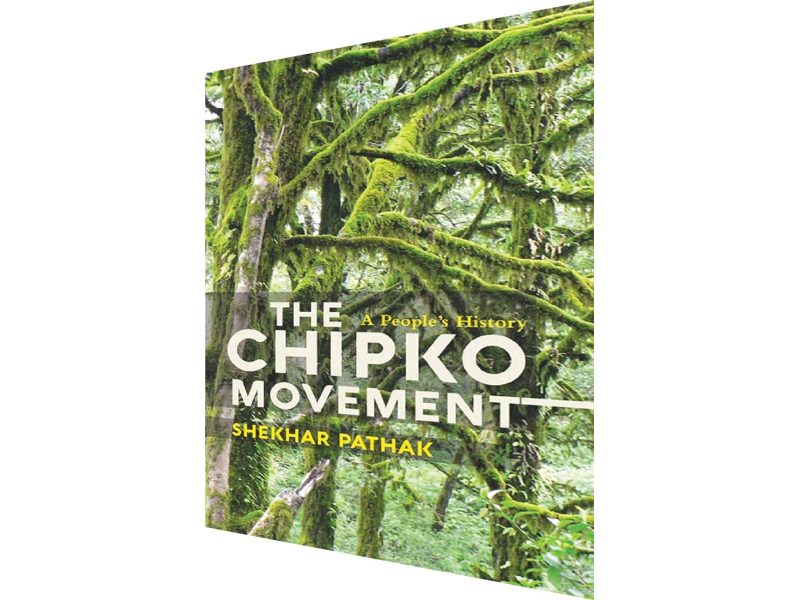Lokesh Ohri (The Book Review)
The Chipko movement: A people’s history; Shekhar Pathak
Orient Blackswan; Rs.895; Pages 390
In the year 1974, when the womenfolk and children of village Reni, under the leadership of the gutsy Gaura Devi, were chasing away labour contractors and their crony forest officials bent upon felling trees for commercial exploitation, writing perhaps the most glorious chapter in the history of the Chipko Movement, a young scholar named Shekhar Pathak was undertaking with a few others, a foot march from the easternmost fringe of Uttarakhand to its westernmost point. This, without a penny in the pocket, the group’s survival during the arduous trek entirely dependent on the charity of village folk.
Having undertaken this difficult journey four more times at an interval of a decade each, and his other numerous travels across the Himalayas coupled with a brief incarceration during the movement, have given him an unrivalled understanding of the mountains and their indigenous settlements and tribes.
No other ecological movement from India has perhaps evoked more global empathy and admiration than the Chipko Movement. Journalistic and anthropological literature on the movement is vast, but barring a few exceptions, limits itself either to discrediting the environmental commitment of the movement as mere mythmaking, or indulges in raking up ego clashes between its leaders.
Needless to say, this has undermined the efforts of Chipko’s foot soldiers, the peasants, students, women and children, who had to contend with poverty, scarcity and precarious circumstances to protect the fragile balance of their forests, relying completely on indigenous wisdom and resources, quite oblivious of the emerging global discourse on ecology.
Despite the movement having provided endless grist to academic and journalistic mills, there has been no detailed history of Chipko until now. By giving us a blow-by-blow account, a ringside view of the movement as it transformed from an effort to seize forest resources from exploiters from the plains into a widespread agitation for a separate State and identity, the author has done a great service not only to scholarship on environmentalism but also to the hitherto unknown subalterns who carried forward the movement in the remote forest patches of the Himalayas, in the face of extreme risk to life and limb.
Described as a “definitive history” by respected historian Ramchandra Guha, who has written the foreword of this book, the author has brought to light several activists whose names, even during the time of Chipko, had been relegated to footnotes and pages of vernacular media or minutes of protest meetings. While acknowledging their role in protecting valuable community resources, which later came to be recognised as natural wealth critical to humanity, he also narrates their often-impoverished circumstances and their familial struggles.
Grassroots movements exist and proliferate in multiple layers of reality. As they progress, they acquire divergent meanings for different people. Chipko also reflected these multiplicities of thought and action. While for the marginalised, especially the valiant women of Uttarakhand, it was an effort to regain the commons and stand up to the might of the ruling classes — the dreaded nexus of politicians, bureaucrats and contractors — for others, it opened avenues for lateral entry into identity politics.
The author dwells upon these multiple layers of meaning. For instance, while describing the conflict between the two most celebrated leaders of the movement, friends who fell apart — Chandi Prasad Bhatt and Sunderlal Bahuguna — he dispels several myths about their disagreements. Pathak points out that their denial of each other even as the movement reached its zenith, was the consequence of Bhatt’s steadfast resolve to save the environment while also generating livelihoods for the communities completely dependent on it, even as Bahuguna adopted a more romanticised view of ecological preservation, almost sacrificing his life in opposition to the ill-conceived Tehri Dam.
Thus Pathak effectively exposes propagandist canards spread against them by interests invested in systematised plunder of the mountains and maintains that the rift occurred on account of differing convictions, even as they both sought to achieve almost similar goals through divergent paths. This book, therefore, makes us ponder what this Himalayan state (Uttarakhand) could have been had the two combined their strengths.
Uttarakhand’s current social and political malaise is linked with this dispute. For a region that rode on the back of ecological and feminist movements towards achieving separate statehood, it has to date, failed to produce a political leader who can present a new vision for a more secure future, environmentally as well as economically to the people. The state has suffered eight chief ministers in two decades of its existence, none meeting the expectations of the electorate in any way. Even more conspicuous by its absence is any credible regional political party.
Answers to these puzzling questions can be found in Pathak’s history of Chipko where minor ideological differences assumed irreconcilable proportions which have forced abandonment of the exalted goals the movement set out to achieve. As a result, currently the social fabric lies so tattered that not a whimper of protest is heard when the insensitive political class in New Delhi and Dehradun announces and builds ill-conceived mega-highways and rail projects to pilgrimage sites, pillaging the ecology only to please the religious vote bank.
This, in a region that engendered a movement as powerful as Chipko. Perhaps Pathak’s history of the Chipko Movement can help us rekindle the sparks that have gone damp.
Also read: Wounds of history: The radiance of a thousand suns
























